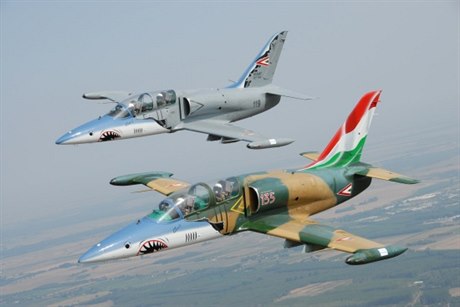The Czech Army early this month ordered the grounding of all nine of L-39 Albatros jet trainer and combat aircraft following an investigation into a December 2010 accident that forced the pilot to eject. Defense Ministry inspectors now say the state-owned LOM Praha is partly responsible for the crash near Třebíč Biskupice. As in other recent accidents involving the subsonic jet fighters, the cause was a so-called titanium fire, and the ministry says LOM failed to implement all prescribed anti-fire safety measures.
Czech Position has learned that the problem is more likely in the construction of the engine itself — which, if true could lead to the grounding of hundreds of aircraft in use worldwide. The Ukrainian manufacturer of the engine in question, Motor-Sich, stands by its work, insisting that LOM made alterations to the engine without consulting the original Ukrainian designer and producer.
Steel in place of titanium
Whoever is to blame, a number of innocent pilots have already paid with their lives, forcing the Czech army in the latter half of the 1990s to instruct a team of experts to carry out structural adjustments to prevent further accidents. LOM technical engineers replaced the titanium parts in the front of the engine with steel ones. For years, training missions continued without incident: until December, when a problem was discovered in the rear of the engine.
Czech experts agree that the cause of the problem with the Albatros — some 3,000 of which are in use worldwide — is that its engine was originally intended for use in the Jak–40 transport plane. Later, after minor alterations, it was produced under the MI 25 TL mark and used in the fighter trainers, which during acrobatic maneuvers, however, are overtaxed.
“It was designed for loads of two to two and a half Gs [G-gorce]. That’s why more titanium alloys are used in the MI 25 TL engine. These are indeed lighter but the engine won’t ‘take such a stress load as in a fighter plane. In multiples of overload a different coefficient of stiffness is manifested,” LOM technical director Jiří Linka, who has worked at the state firm more than 12 years, told Czech Position. Daniel Hanus, head of the flight transport branch of the Czech Technical University in Prague (ČVUT), confirms that engine wasn’t intended for acrobatics. “If the engine is mounted in a fighter jet, the effects on individual parts is a marked gyroscopic force, which leads to increased vibration,” he said, adding that the L–39 engine has inherent design flaws.
Is a tender the answer?
On the basis of the December accident, Chief of the General staff of the Czech Army, Vlastimil Picek, at the end of May decided to ground five L–39s in operation whose service life was ending in 2012. The remaining four planes, which were due to be taken out of service in 2016 and 2020, will be overhauled or have their engines exchanged. To this end, a tender will be held.
“A contributing factor to the fire could be that LOM Praha, due to a long-running dispute with the Ukrainian engine producer, has not implemented all the prescribed measures to eliminate possible cause of titanium fires,” the Defense Ministry said following an investigation into the December 2010 accident. Corrections must be made by the engine producer or under its supervision, the ministry said.
LOM Praha versus Sich
If LOM Praha wants to win the tender regarding the four L–39s to remain in service, it will therefore need to mend relations with its Ukrainian partner. That’s easier said than done, as relations between the Czech company and Motor-Sich, have long been strained. “Cooperation faltered following the collapse of the Soviet Union when the Ukrainian factory shifted its focus over to servicing [rather than producing] engines,” LOM Praha director Jindřich Ploch told Czech Position.
The problems also stem from the scarcity of spare parts. Between the Ukrainian producer and LOM Praha is the firm Dozon of Jiří Tomeš, who has demanded that the Czech state firm grant it an exclusivity contract to supply parts needed to keep the fighter trainers in working order. LOM Praha refused. “For the state enterprise, it is unacceptable for the army to rely upon an intermediary with four employees. Furthermore, business conditions cannot be tied to certification,” Ploch said.
Tomeš told the daily E15 that already two years ago his firm offered LOM Praha “very attractive conditions” to sell the necessary international certificate and project documentation without which it is not possible to service the engines. “And of course we will endeavor that Motor-Sich wins the Czech Army tender directly,” he said, criticizing LOM Praha for altering the engine without the consent of the Ukrainian firm. Tomeš has filed a criminal complaint over the December 2010 accident, citing a general threat to the public.
World’s leading jet trainer
The L-39 Albatros light jet aircraft and trainer was developed under the former communist regime of Czechoslovakia with serial production starting in 1971. The engine was supplied by the then Soviet Union. Production of the plane by the Czech Republic’s biggest aircraft company, Aero Vodochody, ended in 1999.
The aircraft was widely sold throughout the Third World thanks to its versatility and is still widely used; according to some reports, there are around 2,800 planes in service with air forces around the world as well as planes owned as cheap private jets.
The plane has appeared in several films, most famously being used in the James Bond adventure “Tomorrow Never Dies.”





